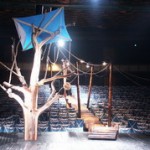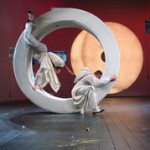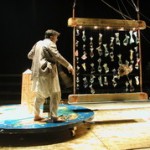Baroque, hedonistic, playful, inspired by childhood memories, from simplest toys to most innocent feelings, Dragos Buhagiar is not afraid of being a nostalgic. He stopped building walls a long time ago: he turned himself into space-generating objects, objects interacting with the actor, playing the game, defining, challenging or getting into drama. He says a scenographer should really be specific, by no means opulent, actually assisting the director and the actors to develop a theme.
That’s what he does, except I felt he really goes into the show, he’s not a discrete presence, but his works are story-telling elements, and not a mere background. In his film, theatre, video scripts, in stage production, lighting design, stands, graph design or costumes, Buhagiar renders feelings in a relaxed and truly personal manner for games he engages in, perfectly contemporary with our times today yet adding a spicy flavour of old times that would amuse or change meanings or rules. There is always a design aesthetic in what he does, in compositions and ideas, except images. He always breaks the stylistic unity in colours or objects, yet keeps on being really precised, really clear. He certainly knows and fully assumes the idea that less could be more, but it bores.
The achimist
In this show, Buhagiar understands for the first time he is not about to set a scenery, he should not make a decor. Being about a desert – he should have avoided a vertical lift and an excessive mass of forms and objects to be able to focus on something else. That was a certain feeling, air, a special light present in the desert. “I realized it was useless to bring sand and started with the sound. I always hear things. Have never been in a desert, rather thought it is a dry area, and the sun onto your head should create all sounds, anything sould be louder and wouldn’t hit anything. It’s quiet as the grave there.” And so he turn the tea shop, full of glassware, into a musical thing.
He remembers the setting from Lean’s film, “Lawrence of Arabia”. In an open and blurred space to the horizon, where no objects can be seen, light is everything. A very special light, almost material, taken from his shooting experience, by using a blending system – a reflected, difuse light as in the Italian one. “I brought public onto the stage because I needed them to stay in this light, changed by the gold leaf collated on everything and the copper sheet. It was a combination of elements with light – never direct, some reflects on the actor, and always deviated.”
For the road, he sets a different object, a rotative platform inspired by kids playing ground. The journey takes place there, on that unique simpleness, nothing real, so that it becomes in turns a road, a ship, the helm. An amazing place changed gradually by the means of an object.
Leonce and Lena
Two difficult staging concepts in this project: how time passes by on a day-night succession and the journey issue. Her and his. Again, space and itineraries sorted out by objects. One scenery, a support-wall to project a circle (child memory again) made possible a whole number of changes. Based on this, the projected circle is the sun, the moon and their meanings come out by colour and light.
The play starts with lifting a spherical shape with a concave mirror focusing light and attention on the exposed area, dramatizing the display. The scriptwriter’s intention was that space and what characters do is under a magnifying glass, as in a lab. That’s how a story starts, and one sees their own world, and also notices the deformed replica of the concave mirror. “That’s what I wanted, because the whole idea of this play is a perception about love, about what love is for people living at the same time, in the same space and having totally different perceptions on feelings, about what life and love mean and how deformed one can see or feel what happens.”
The room where the king’s son makes love to the prostitute is a mechanic toy for sex, as something like that must have looked then – a mixture of music, a sex doll and a Recamier. “Eventually things are not that complicated, they’re quite simple, nothing special about it. I thought about it straightforward: what I would have liked, as experience, if could have lived then. Of course I felt very influenced by Casanova by Fellini. Didn’t copy anything, but used the mechanism of that box used by Casnova, which he opened and found all sorts of stuff, and all very erotic. No analysis, no theory here, I asked in a very practical way what I would have been after, and wanted to give the director and the actor a chance to play with it.
We live in a really composite time, and I’ve embarked on our era. I feel part of it and I say it when I’m inspired by something.”
Godot
In front of a poetic yet hard at the same time, Buhagiar chose to take scenery into the poetic area mostly, however did not contradict it and for which he chose the metaphor. The help of the director he placed spectators onto the stage once again, yet this time the motive was a bad relationship between the audience and the Brasov theatre. People are on the stage and on its seats, the stage turned into a background, there are about 900 kites standing for 900 people with wasted dreams and expectations. A paper kite needs to fly, its place is on the sky but not with Godot where they keep on staying and waiting for someone to fly them in the air.
If so far he uses suggestions and symbols in a poetics taken to extremes, for the tree he is unexpectedly explicit: “I’ve dissected nature, X-rayed Godot’s famous tree where a few leaves appear for a moment, which means it’s still alive. I chose to cut leaves, and at some point the sap flows in the tree, green, as through some veins.” Again we can feel the baroque note, although taken into the contemporary. “I’ve left humans with hope coming from this show. Beckett does not leave any hope. The space is captured there, no exit possible. I opened the story, broke it into pieces. One could say: these kites do give hope, maybe somebody comes and flies them up.”
Elisaveta Bam
“This was a terrible challenge of Toca’s since Harms is really weird, he certainly knows what he meant, I cannot but say I didn’t undertand him though tried to. Actually this is where I placed all my obsessions, had the space to do that, because Harms is so mad he lets you to do so.” It’s still a world of objects in which the scenographer clearly assumes the 20s’ aesthetics. Rain is illustrated by the graphic and the rhythm of that time, the composition is really following the same style, deco art is used, futurist views, the semicircle. A lighting effect emerges since the idea was a farcical comedy/ slapstick comedy in line with time. Objects have multiple positions and meanings, and can work out lots of moments with minimum of means. The table turned into a door that opens up to pass and which, covered by a sheet, converts into a circus element where people fall into, disappear, and then show up again. The procedure is by no means descriptive: children are pins, the egg of creation is a symbol of protection; then a window – no coincidence it looks like a musical instrument since it permeates light, the sky comes in, full of outer sounds. “The theme was threatening in this show and I was to bring innocent objects: the rain, umbrellas. As always, the umbrella seemed a refuge, and I imagined since I was little, that if I let myself down it turns into an igloo and if I add a light it turns into a house.”
Another invented device is the cannon-eye of the former secret services, a really violent one, for looking can kill, and eyes may be guns. “This eye walked and threw flames and killed her. Nothing else to be done, the mere fact you were watched made you dead. Some violins, scythe-ended ones, reaping light and cutting off light. Nature, fire, water and something that obsesses me for long: a pendulum which is that divine force above us, controlling time and showing the bad things we do. An art deco pendulum, an eyeball to flame up and you have no idea if it protects you or not. While she, the main character, was a target, a living target.”
How Emi thinks
A classical text has a higher difficulty for space as the whole action only takes place in two-three different locations. In this show a man was to appear onto the stage, or better speaking, the spirit of a man, not playing but whom is referred to once in a while, he’s the husband of the main character, a painter, a painter obsessed by her. And then the whole staging space was taken into a living or a large studio where work goes on. She shows up everywhere and all objects have his obsessions. The scenography is based on wheeled easels that make up the staging space and that blow up at some point, they’re pulled into pieces and the scene is empty.
“Given that, relating to the text, she loses the house and needs to move out, and she moves out in this object. It’s a painting to show her nude and that’s dismantled and turns into a cabin, the only thing she takes from the house. I meant to physically show this, Symbolically as well, but mainly physically, then the size. The atmosphere is gloomier and gloomier, the object opens up, the scene breaks out, easels get back and stay there. That leaves what Chaplin had, a beginning, a turning to zero, to origins, as a dry joke. That’s the end. We keep on building our whole life yet we leave alone, we don’t take anything with us.”
Foto: Dragos Lumpan




